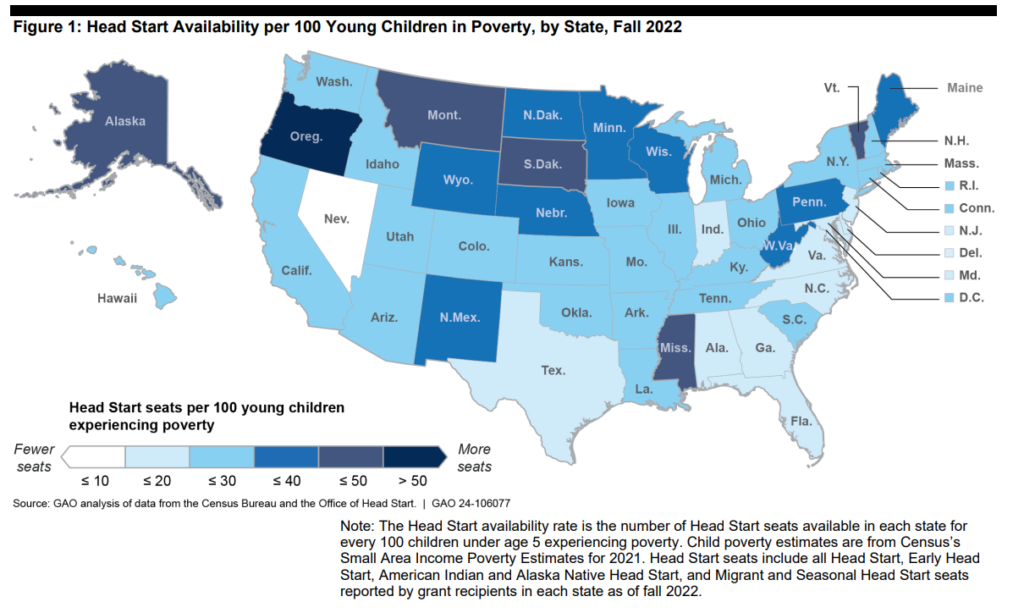GAO Report: Opportunities Within Head Start to Better Align Resources with Child Poverty

Recently, GAO released a report on the availability of Head Start throughout the nation. The report finds that the availability of Head Start programs varies widely across states and counties and that there are mismatches between where income-eligible families live and where Head Start services are available.
Head Start serves nearly 790,000 young children through grants to 1,600 organizations nationwide, but demand far exceeds capacity. In 2020, only about half of income-eligible preschoolers and one in ten eligible infants and toddlers were served due to limited funding.
GAO found that Head Start funding does not align closely with changes in child poverty. Grant recipients generally receive funding for the number of enrollment slots specified in their grant award each year, regardless of whether the number of children eligible for Head Start in the state rises or falls. Head Start officials noted that the annual Head Start funding formula does have several benefits, including helping to protect the continuity of services in the communities where they are located and allowing programs to invest in infrastructure and community relationships. However, it also means that grant recipients in states with rising child poverty can serve a lower proportion of income-eligible children. This results in the program having less flexibility to shift funding to areas most in need.
Key Findings:
- The average rate of Head Start availability among all states was 28 seats for every 100 young children in poverty. This ranged from about nine for every 100 young children experiencing poverty in Nevada to 53 in Oregon.
- States with the lowest child poverty rates had an average of about 31 Head Start seats for every 100 young children in poverty, while states with the highest child poverty rates had an average of about 26 seats. These differences were not statistically significant.
- Counties in the bottom 10% for child poverty—mostly in the South—had fewer than 10 Head Start seats for every 100 young children experiencing poverty, while the top 2% of counties had more seats than young children experiencing poverty.
- There’s wide variation in Early Head Start availability across states, from four seats per 100 children in poverty under age three in Nevada to 33 in D.C.

Why is There Variation in Head Start Availability?
Officials from the Office of Head Start (OHS) cited numerous factors contributing to variations in Head Start availability at state and county levels. This includes Congress not allocating significant funds to address discrepancies as well as the fact that Head Start is a federal-to-local program, which means programmatic offerings are tailored to the community’s needs. Some communities may have high levels of child poverty, but fewer Head Start programs. However, it is important to note that does not inherently mean there is a need for more Head Start programs if the community has robust access to early care and education programs through public pre-k and/or CCDBG-funded programs, for example.
GAO notes that there are several statutory provisions that do not effectively align resources with need in key areas. These include:
Annual Funding: Recent appropriations focus on specific activities (such as prioritizing cost of living adjustments and funding new slots for Early Head Start) rather than distributing new funds to existing grant recipients based on enrollment numbers via the statutory funding formula. This suggests that the statutory funding formula may not be fully responsive to current congressional needs.
Expansion Funding: Head Start funding is also at times available through competitive grants, which can be used to bolster the expansion of Head Start or Early Head Start programs, among other purposes.
- Head Start: There is a statute that provides for two streams of Head Start expansion funding- one is shared by all states proportionally (45%) and the other is reserved for states where relatively less eligible children are served (55%). During the last funding round, 39 states qualified for both funding streams, leading to thinly spread funding. If the same provision is applied today, an even larger majority of states—45 states plus DC—would qualify, further diluting targeted funding and hindering access improvement.
- Early Head Start: The Office of Head Start (OHS) interprets the statute to distribute grant funds equally across states, rather than ensuring equitable access to Early Head Start across states. This approach stems from Congress’s direction during a 2014 funding round when access to Early Head Start was low and there was a need to expand the program nationwide. GAO writes that continuing this allocation approach will “do little to address existing differences in access to Early Head Start services across states.”
Opportunities for the Office of Head Start (OHS)
OHS has the authority to consider geographic imbalances in Head Start resources but rarely does so. The GAO report notes multiple opportunities for OHS to ensure that Head Start resources are targeted to children, families, and communities of greatest need:
- Recaptured Funding Reallocation: OHS can redistribute funds recaptured from under-enrolled programs to areas in the state with high need. Taking into account the current access rates when granting competitive grants could assist OHS in more effectively distributing funding to communities in the state with a greater need for services.
- Regional Competitions: OHS can consider variation in access rates when awarding expansion funding to ensure grants are not disproportionately awarded in states with already high access rates.
- Statutory Exemptions: Certain appropriations act language exempts OHS from distribution restrictions, which allows OHS to exercise some discretion in resource allocation.
- Leverage the Wealth of Data: OHS officials mention that they rely on applicants to describe community needs as part of their grant application, but this approach doesn’t allow for a comparison of needs across communities. OHS could use its data to identify disparities and gaps in Head Start resource distribution. Such an approach would be in line with the Administration for Children and Families (ACF)’s strategic goal of taking a proactive approach to child and family well-being, and using data to anticipate and address needs.
Recommendations
Congressional Consideration. GAO notes that Congress should:
- Consider reviewing and, as appropriate, revising statutory provisions governing the allocation of annual Head Start funding to ensure alignment with congressional priorities and goals for Head Start.
- Consider reviewing and, as appropriate, revising statutory provisions governing the allocation of Head Start and Early Head Start expansion funding to ensure alignment with congressional priorities.
Executive Action. GAO recommends that the Secretary of Health and Human Services (HHS) instruct OHS to:
- Use its current grant-making authority to consider in the geographic distribution of Head Start resources across communities during the competitive grant allocation process, and
- Leverage the data it already gathers to evaluate the relative rates of access to Head Start services and to pinpoint regions where additional services might be required.
Subscribe to FFYF First Look
Every morning, FFYF reports on the latest child care & early learning news from across the country. Subscribe and take 5 minutes to know what's happening in early childhood education.



